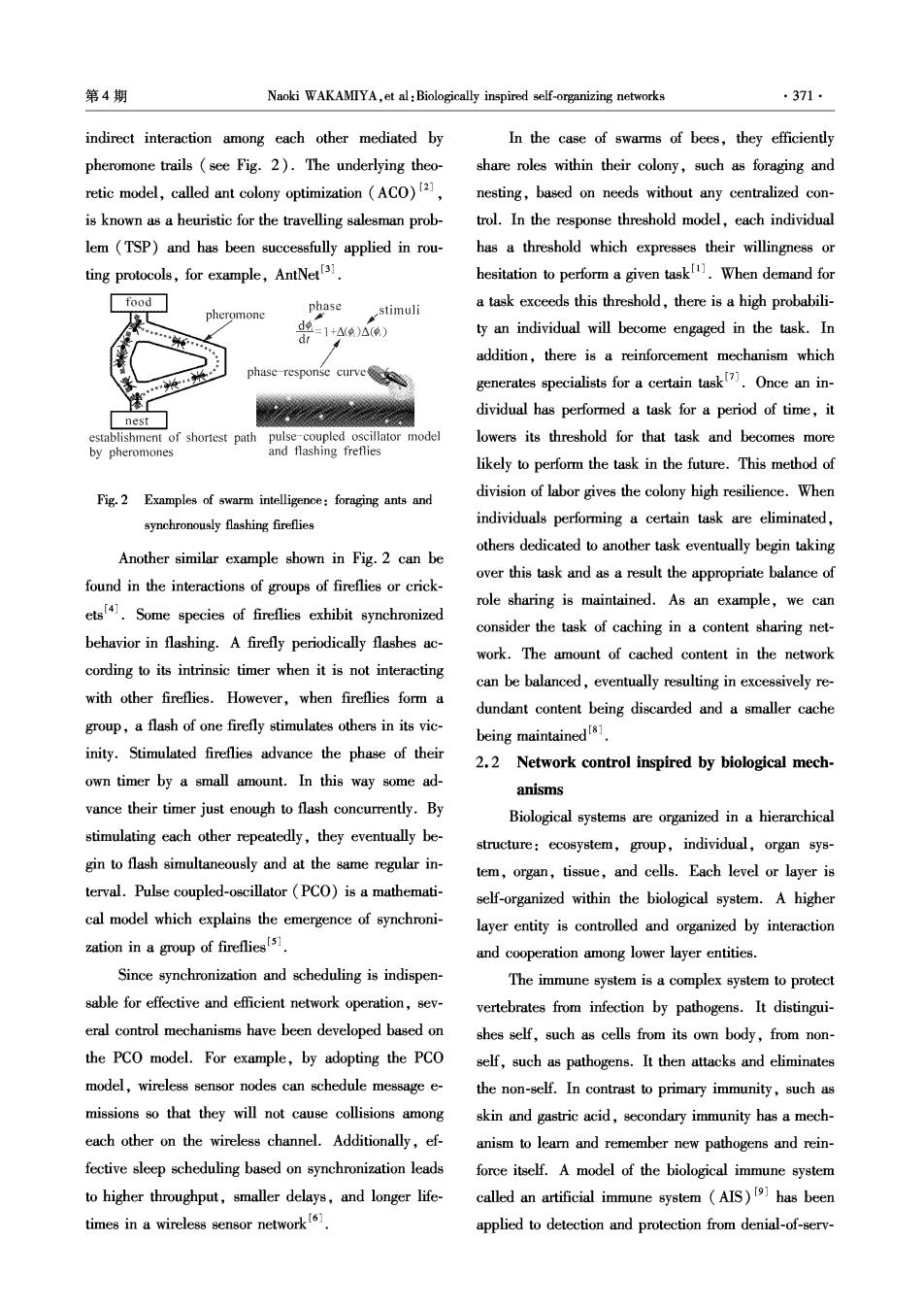正在加载图片...

第4期 Naoki WAKAMIYA,et al:Biologically inspired self-organizing networks .371. indirect interaction among each other mediated by In the case of swarms of bees,they efficiently pheromone trails (see Fig.2).The underlying theo- share roles within their colony,such as foraging and retic model,called ant colony optimization (ACO)2, nesting,based on needs without any centralized con- is known as a heuristic for the travelling salesman prob- trol.In the response threshold model,each individual lem (TSP)and has been successfully applied in rou- has a threshold which expresses their willingness or ting protocols,for example,AntNet[31 hesitation to perform a given task.When demand for food phase pheromone stimuli a task exceeds this threshold,there is a high probabili- d9=1+A)△) ty an individual will become engaged in the task.In addition,there is a reinforcement mechanism which phase-response curve generates specialists for a certain task7.Once an in- dividual has performed a task for a period of time,it nest establishment of shortest path pulse-coupled oscillator model lowers its threshold for that task and becomes more by pheromones and flashing freflies likely to perform the task in the future.This method of Fig.2 Examples of swarm intelligence:foraging ants and division of labor gives the colony high resilience.When synchronously flashing fireflies individuals performing a certain task are eliminated, others dedicated to another task eventually begin taking Another similar example shown in Fig.2 can be over this task and as a result the appropriate balance of found in the interactions of groups of fireflies or crick- role sharing is maintained.As an example,we can ets(41.Some species of fireflies exhibit synchronized consider the task of caching in a content sharing net- behavior in flashing.A firefly periodically flashes ac- work.The amount of cached content in the network cording to its intrinsic timer when it is not interacting can be balanced,eventually resulting in excessively re- with other fireflies.However,when fireflies form a dundant content being discarded and a smaller cache group,a flash of one firefly stimulates others in its vic- being maintainedt81. inity.Stimulated fireflies advance the phase of their 2.2 Network control inspired by biological mech- own timer by a small amount.In this way some ad- anisms vance their timer just enough to flash concurrently.By Biological systems are organized in a hierarchical stimulating each other repeatedly,they eventually be- structure:ecosystem,group,individual,organ sys- gin to flash simultaneously and at the same regular in- tem,organ,tissue,and cells.Each level or layer is terval.Pulse coupled-oscillator(PCO)is a mathemati- self-organized within the biological system.A higher cal model which explains the emergence of synchroni- layer entity is controlled and organized by interaction zation in a group of firefliess). and cooperation among lower layer entities. Since synchronization and scheduling is indispen- The immune system is a complex system to protect sable for effective and efficient network operation,sev- vertebrates from infection by pathogens.It distingui- eral control mechanisms have been developed based on shes self,such as cells from its own body,from non- the PCO model.For example,by adopting the PCO self,such as pathogens.It then attacks and eliminates model,wireless sensor nodes can schedule message e-the non-self.In contrast to primary immunity,such as missions so that they will not cause collisions among skin and gastric acid,secondary immunity has a mech- each other on the wireless channel.Additionally,ef- anism to learn and remember new pathogens and rein- fective sleep scheduling based on synchronization leads force itself.A model of the biological immune system to higher throughput,smaller delays,and longer life- called an artificial immune system (AIS)9 has been times in a wireless sensor network6 applied to detection and protection from denial-of-serv-